4 September 1778

Etching of the new Circus Maximus plan is done, the copper plate is prepared, and the first proof will be printed tomorrow.
4 September 1977
This now was for sure my last full day in Rome, and I have no idea of what I did that day.
4 September 1997
Death of Aldo Rossi.
4 September 2001
Cathedral of Tyre -- answers
I found some answers to the questions regarding the Cathedral of Tyre in T.D. Barnes' Constantine And Eusebius pp. 161-62. For brevity's sake, here are the facts:
1. it was Maximinus Daia in Spring/Summer 313 that "granted the right to [re]building churches," and the source for this is in Eusebius Ecclesiastical History Book 9.
2. Eusebius "in a speech which forms the greater part of Book Ten of the History; he delivered the speech in Tyre about 315, when the rebuilt basilica was dedicated."
I think it is now safe to say that the rebuilt Cathedral of Tyre should not be directly attributed to Constantine. This then seems to open further implication that the churches Constantine IS responsible for are of a distinct set of churches that are special because of their unprecedented Imperial initiation and funding.
4 September 1997 and today
Architect Aldo Rossi died in a car crash 4 September 1997, exactly at a time when virtually all of the world was very aware of another car crash death, namely the death of the quondam Princess Diana, 31 August 1997. Although I did not learn of Rossi's death until a week or two after it happened, I nonetheless vividly remember something I did 4 September 1997, which was to unexpectedly find the essay "Passage to the City: The Interpretive Function of the Roman Triumph" by Alan Plattus in Ritual (1983). Given the fact that I was then soon to see an actual reenactment of the ancient Triumphal Way via the televising of Diana's funeral 6 September 1997, this series of events has (for me at least) over time become more and more compounding (hence EPICENTRAL).
Four years ago tomorrow, 5 September 1997, was the death of Mother Teresa, and the present's 6 September will witness the memorial service for Steven Izenour at Irvine Auditorium on the University of Pennsylvania campus.
Sometime in 1998 I learned of the Eugene J. Johnson article "What Remains of Man -- Aldo Rossi's Modena Cemetery" in The Journal of the Society of Architectural Historians (March 1982), where Johnson adroitly demonstrates how Rossi's cemetery design closely compares with Piranesi's Bustum Hadriani as delineated within the Ichnographia of the Campo Marzio. What Johnson does not point out however, is that Rossi essentially reenacted the Ichnographia's axis of death which actually intersects the Ichnographia's demarcation of ancient Rome's Triumphal Way. [Piranesi's plan delineations of the intersection of the axis of death and the Triumphal Way themselves manifest a reenactment of the ancient Roman camp/urban planed crossing of a cardo and decumanus.]
Triumph via death is not exactly considered a modern theme, yet it is nonetheless still quite capable of being pervasive in modern times. Without much exaggeration, it is indeed possible to view Diana's funeral as a modern event of very, very late antiquity.
4 September 2003
in the thick of reenactment season
Today: I purposefully walked from the front door of the Philadelphia Museum of Art down the Benjamin Franklin Parkway to the far side of Logan Circle and then back to the Art Museum. I did this to get a real sense of the scale of the virtual axis of life within Piranesi's Ichnographia Campus Martius
In reality I was walking across the forecourt of the Philadelphia Museum of Art, then down the steps that Rocky made famous running up, then across Eakins Oval, where the largest painting in the world once was, then down a tree lined allée along the south side of the Parkway stretching for three long blocks, then around Logan Circle, and then back in the direction I came although this time along the north side of the Parkway.
In virtuality I was walking through the Nympheum Neronis high on the Vatican Hill, through the Porticus Neronis, through the Templum Martis (Temple of Mars), through the Area Martis where the Triumphal Way begins its "march" (this is around where the Rodin Museum is on the Benjamin Franklin Parkway, and, as luck would have it, where the route of many of today's Philadelphia parades begin), then I walked around Hadrian's tomb, and then I walked back.
The whole walk took about 40 minutes, and if I had gone all the way to the LOVE sculpture at JFK Plaza across from City Hall, the walk back and forth would have taken just about an hour.
Today, I made mental note of most of the memorials on and along this stretch of the Parkway--Washington Memorial, Civil War Memorial, WWI Memorial, a plaque in the cement on axis at Logan Circle states that the trees along the Parkway were planted on honor of the soldiers of WWI, and a Shakespeare Memorial in front of the Free Library.
When I got back to the top of the famous Art Museum steps, a young Japanese(?) tourist (or new student in town?) asked me (without much English) to take his picture with the Art Museum in the background, and then I told him I'll take another picture of him looking the other way with the Philadelphia skyline in the background.
4 September 2020

Mary Boone's 180 hours of community service hour 160
4 September 2022
As per usual, another tiring day.
|